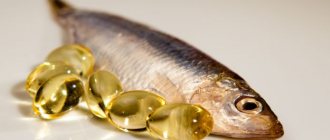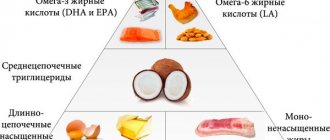07.11.2019 00:00
660
Fat, whether in foods or on the body, is a powerful source of nutrition, providing twice as much energy as carbohydrates or proteins.
Author: Tumanyan Tatevik Sergeevna
Most people only think of fats as cakes, brownies, peanut butter, french fries, and juicy bacon cuts. High blood cholesterol levels are compared to cholesterol in foods. And the fat on the sides looks like it comes from a stick of peanut butter. A high caloric status certainly does not make fat more popular.
However, fat, whether in foods or on the body, is a powerful source of nutrition, providing twice as much energy as carbohydrates or proteins. Thanks to it, it is possible to absorb fat-soluble vitamins A, D, E, K. But, it is important to clearly distinguish between healthy fats and those that harm the body.
Why are fats so important?
Fats have several important functions :
- replenish energy (1 g of fat contains 9 kcal, and 1 g of carbohydrates contains only 4 kcal)
- ensure the absorption of vitamins A, D, E and K, which are soluble in fat (fat is necessary for the body to absorb these vitamins)
- protect organs, nerves and tissues, help regulate body temperature
- every cell membrane in the body needs fat for protection as well as for the growth of new healthy cells
- fats promote the production of essential hormones in the body
- support healthy hair, skin and nails

Some fats are healthier than others . “Healthy” fats – unsaturated, monounsaturated and polyunsaturated . “Bad” fats are produced industrially, these are trans fats , and sometimes include saturated fats .
All fats have a similar structure : a chain of carbon atoms linked to hydrogen atoms. Types of fats differ in the length and type of carbohydrate chain and the number of hydrogen atoms associated with it. Small differences in structure show up in the form and function of fats.
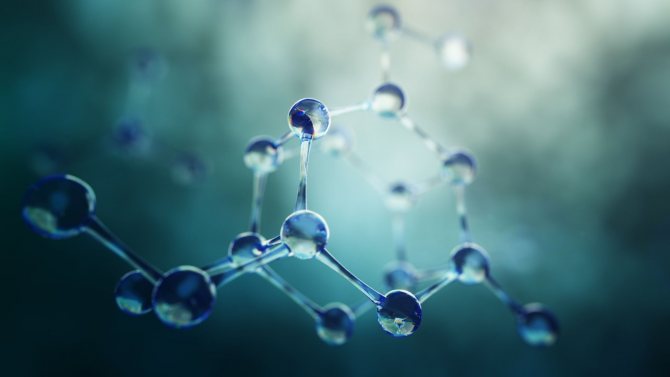
Types of fats
Essential fatty acids are the so-called F vitamins, which until 1930 were considered vitamins, but later it was proven that they are vitamin-like fatty substances, which include oleic, arachidonic, lipolic and linolenic fatty acids. These fats normalize the functioning of the cardiovascular system and prevent atherosclerosis. The daily requirement is 5-10 grams. Sources: vegetable oils from wheat seed, flax seed, sunflower oil, soybeans, peanuts and walnuts. It goes without saying that these fats can also be obtained from fatty and semi-fat fish.
Saturated fats are typically animal fats that are often called unhealthy. In fact, animal fats are not harmful; moreover, they should be included in the diet, as they improve the functioning of the respiratory system. These fats differ in that they remain solid at room temperature, this is due to the fact that their molecules are not linked by double bonds, so they are more stable. These fats also include trans fats, which is why these fats are considered harmful. In fact, if you completely eliminate trans fats and leave only saturated fatty acids of animal origin in your diet, they will be beneficial, although their amount should not exceed 20-30% of the total amount of fat consumed. Sources: butter, animal fat, cocoa butter, coconut and palm oils.

Polyunsaturated fats are unsaturated fats that have a lot of double bonds, these include OMEGA-3 and OMEGA-6. Some sources report that OMEGA-6 are unhealthy fats, but this is not true! Yes, an excess of OMEGA-6 relative to OMEGA-3 can cause an increased risk of a number of diseases, but this does not mean that OMEGA-6 should be avoided completely. The normal ratio of OMEGA-3 and OMEGA-6 is 1 to 4, but in the modern nutrition industry this proportion is violated. This is due to the fact that people do not eat wild foods, which is why there is a need to take additional OMEGA-3 in the form of capsules. To make it clear to you why the ratio should be exactly this, we present a table of the influence of prostaglandins of different groups. Prostaglandins are tissue hormones that do not travel with the blood but regulate cellular and tissue functions. Prostaglandins of groups 1 and 2 are synthesized from OMEGA-6, and group 3 from OMEGA-3.
| Group 1 and 3 | Group 2 |
| Vasodilation | Vasoconstriction |
| Reduced pain sensitivity | Increased pain sensitivity |
| Increased stamina | Decreased stamina |
| Increased immunity | Decreased immunity |
| Increased oxygen flow | Reduced oxygen flow |
| Preventing cell proliferation | Stimulation of cell reproduction |
| Worsening of blood clotting | Improved blood clotting |
| Improved breathing | Deterioration in breathing |
| Prevents inflammation | Promotes inflammation |
Monounsaturated fats are fatty acids that have only 1 double bond, allowing only 1 hydrogen atom to attach to them. In this regard, monounsaturated fats do not clog the circulatory system with cholesterol. Monounsaturated fats are found in olive oil, hazelnut oil, avocados, olives, pistachios and almonds.
Fat requirement
Saturated fats ensure the normal functioning of the central nervous system, brain and lungs, so these unhealthy fats need to be consumed. Neurons function thanks to electrical impulses that reach them along neural chains, which, in turn, are enveloped by the myelin sheath. The myelin sheath is 75% fat, which is why athletes are slowed down during low-calorie diets because they don't have enough fat. The job of the lungs is to carry oxygen, and perhaps this is due to pulmonary surfactant, which also consists of fat. This explains the decrease in endurance during low-calorie diets, since the muscles simply acidify faster. Now pay attention, saturated fats and cholesterol are necessary for the synthesis of testosterone!

Unsaturated fats are involved in the creation of cell membranes and are fat-soluble vitamins, that is, they are necessary for the resynthesis of any cells. These fats are considered completely harmless, and it is recommended to eat more of them. It is worth noting once again that these fats are different and you need to consume them in the correct proportion. In the diet, saturated fats should account for about 70-80% of the total amount of fat consumed. In total, fat should be consumed in approximately 10-15% of the total diet for men and 20-25% for women. Pregnant women can consume more fat, especially animal fat, since it is involved in the formation of the child’s brain and central nervous system.
Bad fats = trans fats
The most harmful type of fats are trans fats . It is a byproduct of a process called hydrogenation, which is used to make liquid fats from healthy oils and prevent them from spoiling later. If you heat vegetable oil in the presence of hydrogen and a catalyst such as palladium, the hydrogen atoms attach to the carbon chain. This process turns the oil into a solid and helps replace healthy vegetable oils with fats that are not as healthy. "liquid vegetable fat" in the nutrition chart . At the beginning of the 20th century, trans fats were found in margarine and vegetable fats , but when large manufacturers learned to use them, they began adding them to everything from cakes and desserts to French fries.
Eating such fats increases the amount of harmful LDL cholesterol in the blood and reduces the amount of good HDL cholesterol. Trans fats cause inflammation , which is linked to heart disease, heart attack, diabetes and other chronic diseases. They cause insulin resistance, which increases the risk of developing type 2 diabetes. A study from the Harvard School of Health and other institutions found that trans fats are harmful to health even in small quantities: for every 2% of calories from trans fats consumed daily, the risk of heart disease increases by 23%.
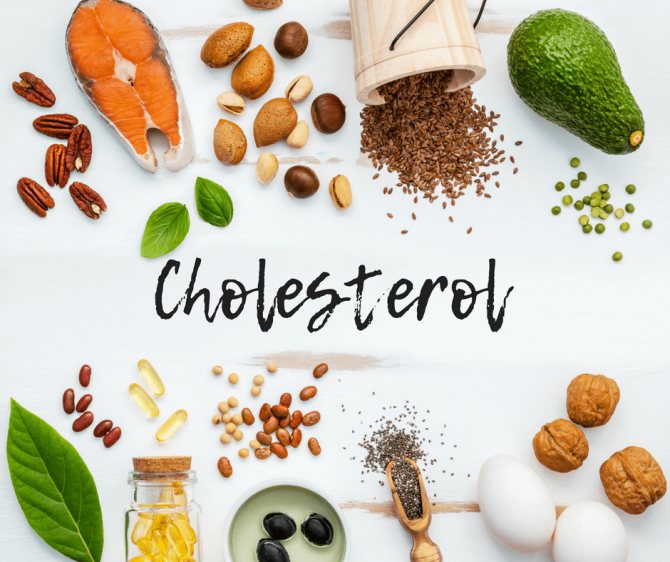
Research has also shown that consuming trans fats can lead to diabetes . Researchers from the Harvard School of Health in Boston recommend replacing trans fats with polyunsaturated fats , which you can find in vegetable oils or fish. This can increase your chance of developing diabetes by 40% .
These fats have been shown to have no beneficial effects on our health , and there is no way to consume them safely. Since 2006, the American FDA (Food and Drug Administration) has required that trans fats be listed as a separate item on the nutrition facts table. As a result, major food manufacturers have reduced the amount of these fats in most foods , and many governments have banned the use of these fats in restaurants, thereby phasing out trans fats from consumption.
The role of fats in human nutrition
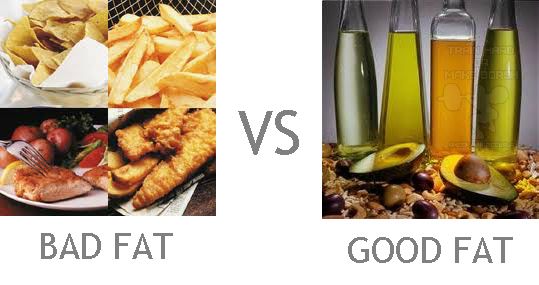
Fats are absolutely necessary in a healthy diet; they play a huge role in ensuring the life of our body. The question is what fats and how much each of us needs. Excessive amounts of fat in food lead to poor condition of cell membranes and increase the stable weight point. Some particularly bad types of fat threaten cardiovascular health and also increase the risk of certain types of cancer.
However, fats cannot be completely eliminated from the diet. They are involved in the absorption of vitamins and the production of cell membranes, hormones and prostaglandins. They improve the taste of food and also control satiety levels in two different ways. When fats enter the stomach, they stimulate the secretion of the hormone esterogastrone, which prevents food from passing through the gastrointestinal tract. Thus, fatty foods stay in the stomach longer, slowing down digestion. At the same time, fatty foods stimulate the secretion of the hormone CCK, which lets your brain know that your stomach is full, thereby controlling your hunger levels. Without fat in the diet, the production of estrogen, which is necessary for bone repair, decreases, i.e. for a process that occurs continuously in a normal body. This causes premature osteoporosis, a disease in which bones become thinner and more fragile, which in turn increases the risk of fractures. Therefore, you should not reduce fat content below the physiological norm.
Bad Fats: Saturated Fatty Acids
Fats that remain solid at room temperature (lard, butter) are called saturated fats. They are found in animal products, including dairy products. The human body is not able to interact with direct molecules of saturated fatty acids; there is simply no use for them in the body. If they are not immediately used by the body as fuel, they are stored in fat cells. Research has shown that, for the same caloric intake, diets high in saturated fat lead to higher percentages of body fat than diets high in protein or carbohydrates.
Saturated fats also increase blood cholesterol levels, which predisposes to heart attacks and strokes. The problem here is precisely the content of saturated fatty acids, not cholesterol, in foods. Cholesterol-rich foods have no effect on blood cholesterol levels because our body reduces its own cholesterol production when it notices cholesterol coming from food. Research has also linked saturated fat in the diet to cancers such as breast, prostate, bladder and colon.
Because saturated fats tend to stick to cell membranes, they reduce the sensitivity of cells to insulin and leptin, leading to increased insulin production and decreased leptin production. This leads to obesity and an increase in the sustainable weight point.
Good fats: unsaturated fatty acids
Unsaturated fats are a much healthier food that remain liquid at room temperature and are called oils. Unsaturated fats are broken down into two subclasses: monounsaturated and polyunsaturated.
Among the monounsaturated fats, the most abundant in nature is the omega-9 fatty acid, oleate. Olive oil is 75% oleate. Monounsaturated fats do not affect the level of cholesterol in the blood in any way - you can drink barrels of them, which is what Mediterranean residents do, and do not suffer from cardiovascular diseases at all. A positive consequence of consuming monounsaturated fatty acids is increased fluidity of cell membranes, which allows hormones and other substances to easily penetrate into cells. This improves protein synthesis in cells and improves insulin sensitivity (that is, fat burning improves).
Polyunsaturated fats include linoleate (omega-6) and alpha-linoleate (omega-3). Our body cannot manufacture these fatty acids itself because it does not have the necessary enzymes for this, so we need to supply them with food. Therefore, polyunsaturated fatty acids are also called ESSENTIAL. You MUST eat these fats. A deficiency of polyunsaturated fats in the diet leads to cell dysfunction, bloody urination, fatty liver and various genitourinary diseases, inability to get pregnant, and so on.
Polyunsaturated fats are the most liquid of all fats (olive oil will thicken in the refrigerator, and flaxseed oil will not harden even in the freezer) and most of all help the fluidity and permeability of our cell membranes. In addition, omega-6 fats are not even close to the health benefits of omega-3 fats.
Omega-3 fats protect heart and vascular health by suppressing the production of “bad” cholesterol and promoting the production of “good” cholesterol. Replacing saturated fat in the diet with omega-3 fats in the same amounts reduces mortality from cardiovascular disease by 70%.
Omega-3 fats help reduce the amount of fat in the body because all omega-3s that enter the body with food are immediately taken up by cells for internal needs. Not an ounce will be deposited in fat reserves. This fat is precious from the body's point of view.
Omega-3 fats also help you lose weight by increasing the level of special fat-burning proteins in the body. These proteins help you burn more fat by accelerating thermogenesis, allowing you to immediately burn more calories without storing them as fat.
Finally, omega-3 fats have a positive effect on leptin. They counteract the harmful effects of saturated fat by increasing leptin sensitivity and leptin production. This directly helps those losing weight achieve a long-term reduction in their sustainable weight point.
According to the latest data from scientists, the most beneficial ratio will be 1:4 between omega-3 and omega-6 in the diet. Unfortunately, the diet of modern humans is so low in omega-3 fats that these proportions are close to 1:20. Overproduction of hormones from omega-6 fats leads to a wide variety of diseases, such as hypertension, allergies, rheumatoid arthritis, strokes and heart attacks. Eskimos consume an average of 14 g of omega-3 per day through fish and whale liver. They practically do not have cardiovascular diseases. In one Eskimo town, not a single cardiovascular disease has been reported since 1970!
Killer fats: trans fats
One type of unsaturated fatty acid is completely unacceptable in a healthy diet - trans fats. They are obtained in the production, for example, of margarines, by the method of partial hydrogenation of liquid oils, which makes it possible to obtain plastic unsaturated fats that are solid or creamy at room temperature and can be stored forever. Trans fats in the modern human diet are the main culprits of the current epidemic of cardiovascular diseases and cancer. Fats generally make up approximately 40% of all calories in the modern diet. 8% of all calories in the modern human diet are trans fats, found in almost all types of industrially produced baked goods, sweets and other types of food: salad dressings, donuts, potato chips, children's cookies, factory-breaded chicken and fish, and so on. In a few years, all food manufacturers in America will be required to list the trans fat content of their products and ready-to-eat meals. In the meantime, read labels and avoid anything made with margarine or containing “partially hydrogenated” fats and oils.
Saturated fats – are they healthy?
Saturated fats are used all over the world. At room temperature they are in a solid state. The most famous sources are red meat, milk and dairy products, cheeses, coconut oil, baked goods and more. The word “saturated” refers to the number of hydrogen atoms surrounding carbon atoms . A chain of carbon atoms that holds as many hydrogen atoms as possible is called saturated hydrogen.

Coconut oil
Coconut oil led to lower triglyceride levels compared to butter and beef in two different studies. However, the overall conclusions about coconut oil are mixed because it does not improve triglycerides any more than unsaturated sunflower oil. And while some saturated fatty acids are linked to increased LDL cholesterol, coconut oil is a blend of the fatty acids that were found to be beneficial in the study (myristic acid and palmitic acid, which together make up about a quarter of the fats in coconut oil). Thus, coconut oil is not bad for the body and is not beneficial .
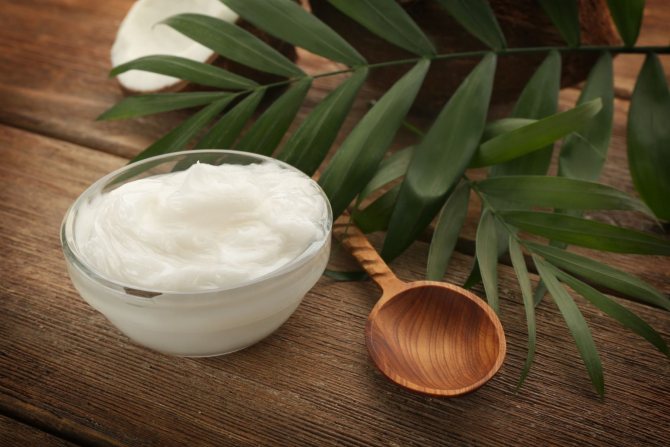
Palm oil
Studies have shown that palmitic acid, which is the main saturated fat in palm oil, has the same effect on cholesterol lipids as polyunsaturated oleic acid . In addition, palm oil contains linotinic and oleic acids and vitamin E tocotrienols , which are strong antioxidants and also inhibit cholesterol synthesis . Thus, it has been proven that palm oil also has no harmful or beneficial effects on the human body. One of the main reasons many people criticize palm oil is its negative impact on the environment. Palm oil cultivation is linked to deforestation, which leads to climate change. Also, palm plantations and their subsequent burning affect some endangered animal species found in tropical areas.

A diet high in saturated fat can cause cholesterol levels to increase and tip the balance toward harmful LDL cholesterol, which causes clogged blood vessels. This is why experts recommend limiting your intake of these fats to less than 10% of your daily caloric intake.
Recent findings point to a link between saturated fat and heart disease. One meta-analysis of 21 studies found that there was insufficient evidence to conclude that saturated fat increases the risk of heart disease, but it found that replacing saturated fat with polyunsaturated fat may reduce the risk of heart disease.

Two other studies concluded that replacing saturated fat with polyunsaturated fat, such as vegetable oils or high-fiber carbohydrates, is the best option for reducing the risk of heart disease. Conversely, replacing saturated fat with highly processed carbohydrates may have the opposite effect. What's interesting, however, is that recent analyzes of red meat and saturated fat show no evidence of a direct link to heart disease. Although saturated fats serve an important metabolic function and do not appear to be harmful or beneficial to the body, you should not consume too much of them.
The benefits and harms of saturated fats
Saturated fats are fats that have a number of beneficial properties that a person needs for the thyroid gland to function normally. They also protect against hypothermia, and food tastes better with them.
Here are the top 5 benefits of saturated fat:
1. Brain health
The brain is mostly made up of fat. Strange, but true. The brain needs fats to grow, regenerate, and stay healthy.
2. Cardiovascular Health
Saturated fats are good for the heart and circulatory system. For example, lauric and stearic acids, found in saturated fats, help regulate cholesterol levels.
Additionally, dietary saturated fat reduces lipoprotein levels, a known risk factor for cardiovascular disease.
3. Bone Health
Saturated fats are essential for effective calcium absorption. Without them, the bones will be weak.
4. Immune health
Without enough saturated fat, the ability of white blood cells to recognize and destroy foreign organisms such as viruses, bacteria and fungi is reduced.
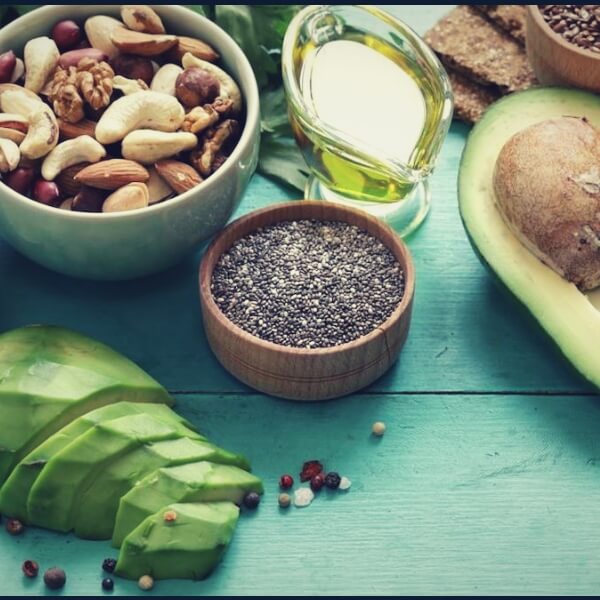
5. Nervous system health
Saturated fat is an “insulating coating” for the nervous system. When a person lacks saturated fat, he becomes more susceptible to various irritants.
Where are saturated fats found?
Coconut oil, butter, grass-fed butter, ghee, natural animal fats, avocados, olives, nuts and seeds, etc.
However, depending on your unique metabolism, the amount of saturated fat that's right for you may vary.
Let's take a closer look at the most popular product - butter.
Although butter is considered a high-calorie product, it also has many beneficial properties. For example, the oil contains vitamin A, which is necessary for good vision and skin elasticity; Vitamin E – helps fight cancer and prevents the formation of wrinkles. But if you have high blood cholesterol levels, it is better to avoid butter.
There must be moderation in everything. Depending on the individual's unique metabolism, the required amount of saturated fat varies from person to person.
The norm for saturated fat is 7% of daily calories. Consumption of saturated fats in excess contributes to rapid weight gain and obesity, leading to the development of cardiovascular diseases and atherosclerosis.
Healthy fats = unsaturated fats
Healthy fats are found primarily in vegetables, but are also found in nuts, seeds and fish. The difference between them and saturated fats is that they have fewer hydrogen atoms associated with the carbon chain . Healthy fats are liquid at room temperature, not solid. There are two most well-known categories of healthy fats: monounsaturated and polyunsaturated fats.
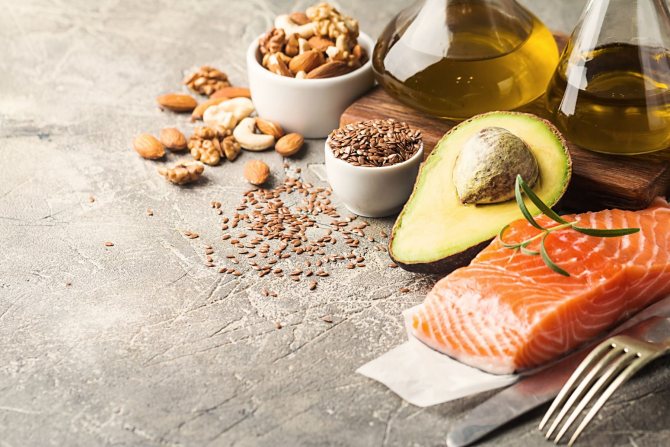
Monounsaturated fats
When you soak bread in olive oil at an Italian restaurant, you're consuming mostly monounsaturated fat . Monounsaturated fats have one double bond on their carbon atoms. This means they have 2 fewer hydrogen atoms in their chain than saturated fats. It is this structure that leaves fats in a liquid state at room temperature.
For example, olive oil, peanut butter and butter, avocados and most nuts, and sunflower oil are good sources of healthy fats.

The Seven Countries Study, conducted in 1960, concluded that monounsaturated fats may have health benefits. have been shown to be less susceptible to cardiovascular disease despite consuming high amounts of fat. The reason is that the fats in their diet are not of animal origin, as in countries where cardiovascular disease was common. Their diet mainly consists of olive oil, which contains monounsaturated fats . This fact has increased interest in this type of oil and in the Mediterranean lifestyle.
Although there is no source on recommended intake amounts for these fats, it is recommended to consume as much of them as possible along with polyunsaturated fats as a complete replacement for saturated and trans fats.
Polyunsaturated fats
Polyunsaturated fats are essential fats, which means they are necessary for the body , but the body cannot make them itself, so you must get them from food. Polyunsaturated fats in the body form cell membranes , nerve sheaths, and are also necessary for blood clotting, muscle movement and inflammation.
There are two types of polyunsaturated fats: omega-3 and omega-6 fatty acids. The numbers 3 and 6 refer to the distance between the start of the carbon chain and the first double bond. Both types are healthy . Consuming these fats reduces bad LDL cholesterol and increases total cholesterol. They also reduce triglyceride levels.
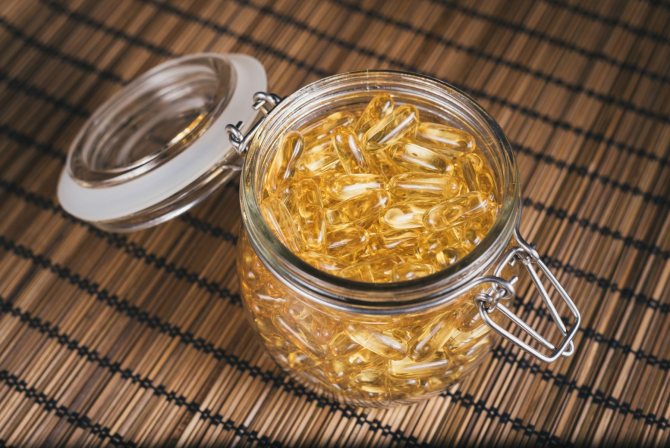
Good sources of omega-3 fatty acids include fish, which are high in fat, such as salmon, mackerel and sardines, walnuts, and other nuts and seeds.
Omega-3 fatty acids
Omega-3 fatty acids may prevent and even treat heart disease and stroke. They also lower blood pressure and increase HDL cholesterol levels. There is also evidence that they may reduce the need for corticosteroid therapy in people with rheumatoid arthritis. Studies linking omega-3s to a wide range of other health benefits, including reduced risk of dementia, are inconclusive, and some have found significant and noticeable deficiencies.
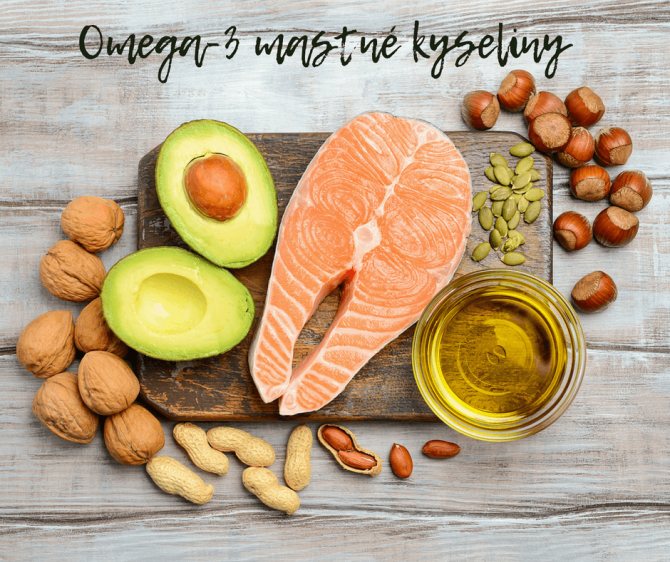
A study examining the effects of omega-3 fatty acids on vision confirmed that the acid DHA found in omega-3 fatty acids is a major component of the brain and retina. Regular use of omega-3s has been associated with a reduced risk of macular degeneration, which is one of the most common eye diseases leading to vision damage and loss.
Omega-6 fatty acids
Omega-6 fatty acids are also used to prevent heart disease . Foods rich in linoleic acid and other omega-6 fatty acids are, for example, vegetable oils such as corn, sunflower and soybean.
A study of nearly 40,000 participants across 20 different experiments found that people with higher blood levels of linoleic acid (one of the main components of omega-6) were less likely to develop type 2 diabetes than people with lower levels of the fatty acid.
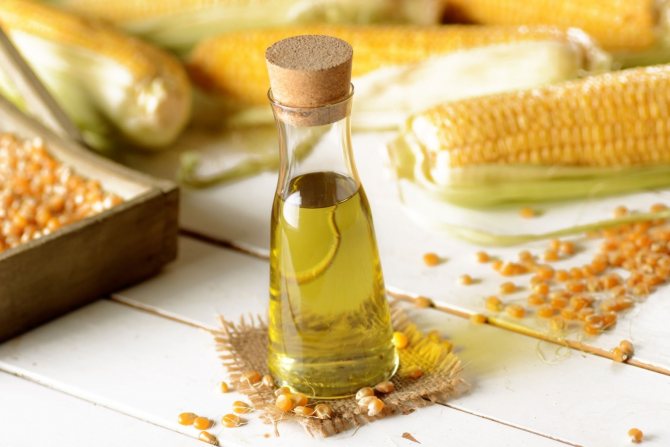
Although omega-6 appears to be beneficial, scientists from the American Heart Organization (AHA) warn that daily intake should not exceed 5-10% of total daily energy intake , as increased amounts have been linked to heart disease and inflammation.
How do you feel about fats? Do you limit their consumption or vice versa? Write us an answer in the comments and if you liked our article, be sure to share it with your friends.
Fats: benefit or harm?
Fats are a source of energy for our body. When burned, one gram of fat “gives off” 9 kcal.
But not only!
Fat is a kind of “building” material for the construction and renewal of cells and tissues. Fats differ both in origin (animal and vegetable) and in fatty acid content (saturated, unsaturated, including mono- and polyunsaturated).
Why is this fat needed?
A sufficient amount of fatty acids entering our body with food is necessary to maintain the balance of hormonal, metabolic, cellular and other biological processes. Thus, phospholipids prevent the strong deposition of cholesterol on the walls of blood vessels, vitamin A is good for vision and growth, vitamin D is responsible for phosphorus-calcium metabolism, and vitamin E is an excellent antioxidant. The optimal amount of fat in food is also necessary for lipid metabolism, the production of cellular hormones, and the stability of cell membranes.
A higher content of polyunsaturated fatty acids in the lipid layer of cells, especially Omega-3, reduces blood clotting, prevents the formation of thrombosis, promotes a high level of sensitivity of liver and muscle cells to insulin, and promotes better perception of impulses by the muscle cells of the heart. How much can you do without harm? Your diet can be considered balanced if its caloric content is provided by nutrients in the following proportions. The share of carbohydrates should be 55-70% (including 10% - “simple” carbohydrates), the share of proteins - 10-15%, fats - 20-30%. As you can see, fats account for about a third of the calories. In terms of 1 kg of weight of a person of normal build, this is approximately 1 gram of fat.
Therefore, your daily fat intake is 60-70 grams. When consuming them (including cooking), try to adhere to the 50/50 principle, that is, you should consume vegetable and animal fats equally throughout the day.
This can be achieved by knowing the fat content of foods. For example, 2 tablespoons of vegetable oil is 30 grams of fat; 20 grams of butter contains 15 grams of fat, 100 grams of 5% cottage cheese or 30 grams of cheese with 17% fat content will contain 5 grams of fat. One glass of milk or kefir (3.2% fat) will contain about 8 grams of fat. In lean beef (weighing approximately 80-90 grams) the proportion of fat will be 7 grams, and in medium-fat fish (a serving of 140 grams) - 5-10 grams of fat.
What to avoid?
Particular attention today is paid to trans fats and palm oil and their impact on health. If we talk about palm oil, then in itself it is harmless, and even contains vitamin E. It begins to acquire hazardous properties for health if low-quality fractions of this oil are present in products (especially confectionery products from stores).
Trans fats—vegetable oils industrially processed into solid margarine—can pose a great danger. It is these fats that are most harmful to health, since their consumption provokes obesity, the development of atherosclerosis, diabetes, and inflammatory processes in the joints. A lot of these fats are found in confectionery products, as well as in deep-fried foods - chips, crackers. Therefore, it is better to refrain from consuming such products, especially those that combine unhealthy fats with sugar or salt. It is also better to treat soft margarine spreads with caution, carefully reading the labels on their packaging and keeping their consumption to a minimum.
What to choose?
As we have already said, your daily diet should contain fats - vegetable and animal in equal proportions. Diversify your menu with vegetable oils - sunflower, olive, soybean, corn, flaxseed. They are very useful for metabolic processes, help prevent atherosclerosis and even have a choleretic effect. Don't exclude animal fats. If possible, enrich your diet with fish. Its optimal consumption is twice a week, including once a week you can eat fatty fish (salmon, halibut, mackerel).
The most important thing in using fats is to be smart about their selection and consumption.
Only in this case, both vegetable oils and animal fats will bring benefit, rather than harm, to your body.
Author of the article: Ruzanna Azatovna Eganyan, Candidate of Medical Sciences, leading researcher at the National Medical Research Center for Preventive Medicine of the Russian Ministry of Health
Do fats make you fat? Yes. From vegetable
Maltseva Oksana Alexandrovna
Nutritionist
The main foods that make you fat are carbohydrates. So what about fats? After all, it is they who most people blame for gaining excess weight and deteriorating health. Don't they really make you fat and sick?
They get fat and get sick.
But not at all from those who are usually accused of this. People get fat and get sick not from animal fats, but from vegetable oils. Moreover, vegetable oils have a negative effect on the human body in two of their forms: as trans fats and as regular liquid vegetable oils.
Harm of trans fats to humans
Currently, scientists have no doubt that the most harmful substances we eat are trans fats, which are hydrogenated vegetable fats. It has been established that trans fats plunge the human body into real chaos, affecting it at the cellular level.
Cancer:
Trans fats block the work of enzymes that are responsible in the body for the fight against malignant neoplasms.
Diabetes:
these fats bind to cellular insulin receptors and the hormone simply cannot work.
Decreased immunity:
trans fat molecules reduce the effectiveness of the immune response.
Problems in the sexual sphere:
trans fats interfere with the normal production of sex hormones.
Interference with the normal functioning of beneficial omega-3 fatty acids.
Heart diseases:
Trans fats contribute to clogged arteries.
Obesity
Asthma
Alzheimer's disease
Behavioral disorders
(aggressiveness, tendency to violence).
In general, it is easier to say which body functions are not affected by trans fats than to list all the adverse health effects that are associated with them.
Trans fats: in what foods are they found?
At home, the main source of trans fats is margarine. But that's not the worst thing. Margarine is easy to avoid.
The worst thing is that the food industry runs on trans fats. So the answer to the question “trans fats: where are these terrible compounds found?” will sound like this: wherever possible. They can easily be found in any product prepared not at home, but industrially. It could be cookies, or sausage, ketchup or a frozen casserole. Doesn't matter!
Therefore, if you want to protect yourself from the toxic effects of trans fats, you should not only eliminate margarine from your diet, but also forget about all prepared foods from frozen dough to sausages.
Vegetable fats are more dangerous than trans fats
Trans fats are terrible. However, regular vegetable oils can be even worse. In this case, the drama of the situation also lies in the fact that, unlike trans fats, the harm of which is widely known, vegetable oils are an enemy whose existence few people realize, and therefore do not think about defending against. Moreover, he voluntarily lets you into his home with open arms.
Of course, what has been said does not apply to all vegetable fats without exception, and you can always answer the question of which vegetable oil is the healthiest. Everything is determined by its composition, and the influence of this composition on the human body.
Harmful vegetable fats
The most dangerous to health are polyunsaturated vegetable oils. They are also the cheapest and most frequently used. These are sunflower, corn, soybean, rapeseed, cottonseed, and safflower oils.
Why are these fats so dangerous?
The harm of these oils is associated with two of their features.
• Firstly, these are all polyunsaturated, and therefore very unstable fats. And since they are not stable, they absolutely cannot be subjected to heat treatment, since when heated they oxidize and form a huge amount of toxic compounds, for example, oxidized triglycerides.
Poisonous oxidation products of vegetable oils have no less, and, according to some studies, even stronger negative effects on the human body than trans fats.
So you need to remember the following: unsaturated oils are, in principle, not intended for cooking. And if you bought sunflower oil, you can season a tomato salad with it, but you can’t fry eggs with it.
• Secondly, all of the vegetable oils listed are rich in omega-6 fatty acids. The human body needs omega-6 fatty acids, but not in such quantities as it receives them today.
At the same time, it is dangerous not only to have an excessively large amount of omega-6 fatty acids as such, but also to have an incorrect ratio of omega-6 and omega-3 fats.
At the present time, for all people who constantly eat vegetable oils and, most importantly, cook with them, this ratio differs from normal by 10 times or more.
It has been established that an excess of omega-6 fatty acids threatens the early development of atherosclerosis and other vascular diseases, asthma, arthritis, the formation of tumors and malfunctions of the immune system.
From the infographic you can get more detailed information about which oils you can fry with and which ones you should not fry with.
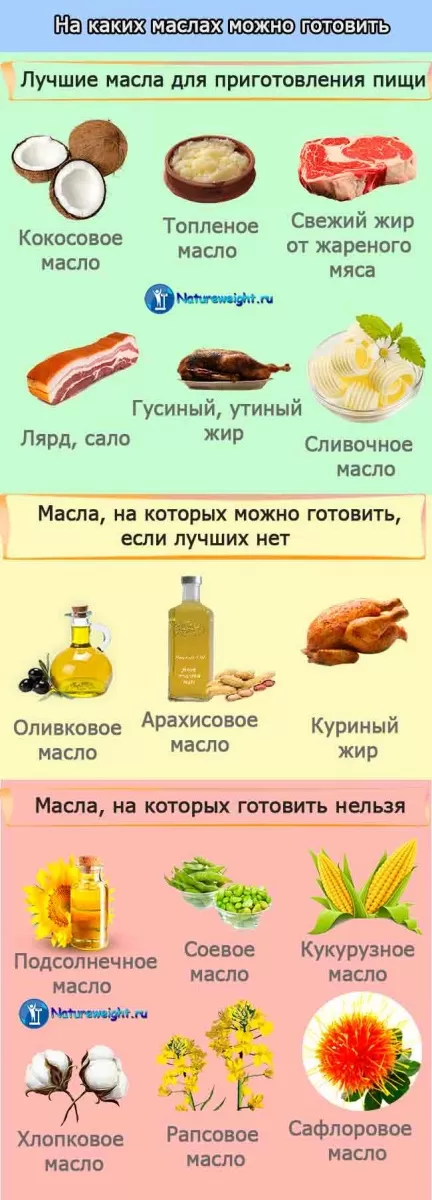
Healthy vegetable fats
The healthiest vegetable oil is coconut oil. Why? Yes, because, despite its vegetable origin, it is a saturated oil, that is, when heated, it does not oxidize and does not form life-threatening compounds.
Palm oil has similar properties, the harmful properties of which were attributed not by scientists, but by corporations engaged in the production of cheap vegetable oils, in particular soybean, and who fear that palm oil released onto the market could reduce their income.
Other healthy vegetable oils include olive oil and avocado. Both of these oils are monounsaturated and therefore do not oxidize very much during heat treatment. In addition, olive and avocado oils contain a lot of omega-3 fatty acids, the very ones that modern people lack so much.








